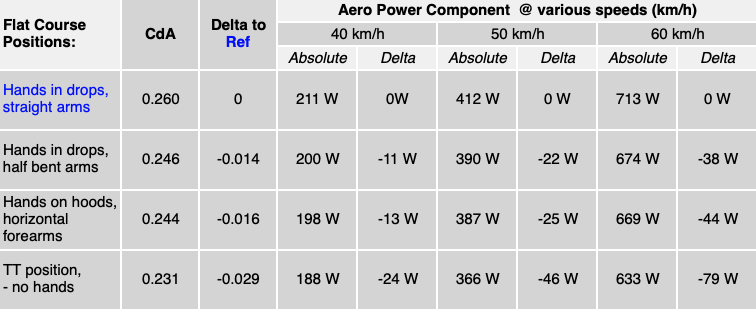Aero data shows effects of banning super tuck and forearm time trial positions
Data analyses the aero savings afforded by the soon-to-be-banned position


Analysts at Swiss Side have provided data on the effect that banning aerodynamic positions will have on pro racing speeds and breakaways.
The UCI will ban the 'aero tuck' position, which provides an aero advantage on a descent, from April 1, alongside a range of new measures to improve rider safety.
It also plans to ban the forearm TT position which some riders adopt on road stages, placing their forearms on the handlebars to achieve a flat-back.
The benefit afforded by any position will be influenced by a myriad of factors - not least the rider's individual frontal area and the speed at which they're riding. Whether a breakaway rider is being chased by a solo rider also capable of adopting a more aero position, or a larger peloton where more control is required, also influences the advantage at stake.
However, data provided by Swiss Side shows that the lost advantage could be as much as 30-seconds per 10km, when riding an 8 per cent descent at a speed of 70 kilometres per hour. It estimates this to translate to a lost 5/kph in speed.

Swiss Side, which produces its own products and also offers services to a range of brands, says it used its 'already available wind tunnel data' to compare a standard on the saddle descending position vs a top-tube mounted descending positon.
The results all compare power required on an 8 per cent descent, and Swiss Side says: "In terms of speed and time on the 8% descent, we calculate that the Super-Tuck position sitting on the top tube will bring a 5km/h higher top speed and save 30 seconds per 10km of descent.
The latest race content, interviews, features, reviews and expert buying guides, direct to your inbox!
"So this means a rider can potentially build a 30-second gap through the aerodynamic drag saving of this position if they are riding in the Super-Tuck compared to a chasing rider or group who is not."

The time trial position is also due to be banned on road stages. This sees riders adopt a flat-back position, resting their forearms on the handlebars, to gain an advantage on the flat.
Swiss Side testers compared a rider using TT extensions in its data, vs sitting up on the bars - though if the pictures are representative then it used a straight arm position, in the drops, as opposed to a more aero hunch which would exaggerate the data.
Still, the testers found a saving of between 24 watts and 41 watts as a result of this position.
How much faster is a TT bike, really?
This tallies pretty well with Cycling Weekly's own windtunnel testing - where we found substantial differences between a straight arm on the drops positon vs using aero bars at 40kph, showing clip-on-bars provided a huge saving vs the minimal benefit up upgrading to a dedicated time trial bike unless speeds are in excess of 50kph.

Swiss Side stated that the findings would add up to an advantage of around 13 seconds, or 180m, per 10km.
Caveating the results, it added: "However the assumption here is that the leader of chasing group is not riding in the TT position. Providing everyone is riding the same position, i.e. both the leader of the breakaway and the leader of the chase group, then there is no difference. However in reality, the chase group (or peloton) is never quite as disciplined as the breakaway rider(s) and the lead rider of the chase group is not always using the best aero position."
Concluding the data, the brand stated: "In terms of aerodynamics, the impact is clear, quantifiable and undeniable. Banning the Super-Tuck position on descents will increase aerodynamic drag and decrease speed.
"On the flat, banning the TT-position on the road bike will have the similar effect and take the sting of what is achievable by breakaway riders by reducing the physical distance and time they can gap themselves to the peloton. Tactically, it simply reduces the tools the riders and teams have in their bag to plan and execute attacks."
The UCI is banning the position as part of several measures aimed at improving rider safety.
Swiss Side added: "Certainly there is an element of risk involved in riding either position, because the level of control on the bicycle is reduced. It could be argued that professional cycle racing is not just about the physical abilities of the riders but their technical skill and abilities to ride their bike. This certainly is the case in mountain bike and cyclocross racing, why should it be any different in road racing?
"Furthermore the excitement in road racing also inarguably comes from the tactics and the breakaways.Take this away and the racing will be less exciting and thereby less entertaining. In any case, it is indeed true. With this rule change, the aero engineers are not amused!"
Michelle Arthurs-Brennan the Editor of Cycling Weekly website. An NCTJ qualified traditional journalist by trade, Michelle began her career working for local newspapers. She's worked within the cycling industry since 2012, and joined the Cycling Weekly team in 2017, having previously been Editor at Total Women's Cycling. Prior to welcoming her first daughter in 2022, Michelle raced on the road, track, and in time trials, and still rides as much as she can - albeit a fair proportion indoors, for now.
Michelle is on maternity leave from April 2025 until spring 2026.
